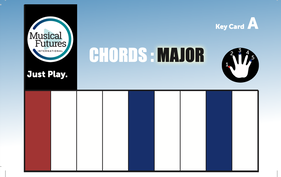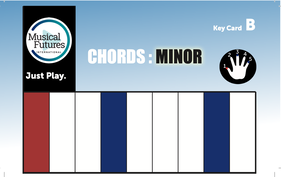| |||||||
| |||||||
| |||||||
| |||||||
| |||||||
Top Tip: The files are in PDF format and should be printed to scale. Make sure you don't 'fit to page' or you'll have some problems when you come to use these! Always print 1 as a trial and make sure it fits before you print a class set!
How to use the Chord Key Cards to play triads
*COMING SOON* New key cards to support construction of riffs, melodies and improvising using different scales.
For now, students can use the major and minor pentatonic key cards to start to explore these concepts.
Top Tip: Use the musical language associated with hearing and playing chords and scales in context. Students will assimilate some of the theoretical concepts as they play and hear the key terms in context.
For now, students can use the major and minor pentatonic key cards to start to explore these concepts.
Top Tip: Use the musical language associated with hearing and playing chords and scales in context. Students will assimilate some of the theoretical concepts as they play and hear the key terms in context.
Top Tip: Smaller children will find it difficult to use fingers 1,3,5 so it's fine for them to use 2 hands. Just make sure they don't twist their hands and you can model different ways to play as you work around as they play along with the music. If they can only manage one note, they should play the root which is always coloured red on the resources. They can then add in notes 3 and 5 as they get used to playing triads.
Final thoughts: At the start we encourage students to jump between the triads in root position. This helps them to understand how chords are constructed - built on a root using notes 1,3,5 of the scale. However you can move onto modelling inversions and other ways to move between chords as appropriate for your students and your approach to teaching and learning in your context.







